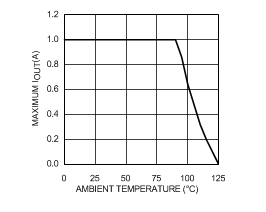JAJSHL5H October 2011 – June 2019 LMR24210
PRODUCTION DATA.
- 1 特長
- 2 アプリケーション
- 3 概要
- 4 改訂履歴
- 5 Pin Configuration and Functions
- 6 Specifications
-
7 Detailed Description
- 7.1 Overview
- 7.2 Functional Block Diagram
- 7.3
Feature Description
- 7.3.1 COT Control Circuit Overview
- 7.3.2 Start-up Regulator (VCC)
- 7.3.3 Regulation Comparator
- 7.3.4 Zero Coil Current Detect
- 7.3.5 Overvoltage Comparator
- 7.3.6 On-Time Timer, Shutdown
- 7.3.7 Current Limit
- 7.3.8 N-Channel Mosfet and Driver
- 7.3.9 Soft Start
- 7.3.10 Thermal Protection
- 7.3.11 Thermal Derating
- 8 Application and Implementation
- 9 Layout
- 10デバイスおよびドキュメントのサポート
7.3.11 Thermal Derating
Temperature rise increases with frequency, load current, input voltage and smaller board dimensions. On a typical board, the LMR24210 is capable of supplying 1 A below an ambient temperature of 90°C under worst case operation with input voltage of 42 V. Figure 20 shows a thermal derating curve for the output current without thermal shutdown against ambient temperature up to 125°C. Obtaining 1-A output current is possible at higher temperature by increasing the PCB ground plane area, adding airflow or reducing the input voltage or operating frequency.

θJA=40°C/W, VOUT = 3.3 V, ƒSW = 500 kHz.
(tested on the evaluation board)
Figure 20. Thermal Derating Curve (tested on the evaluation board)